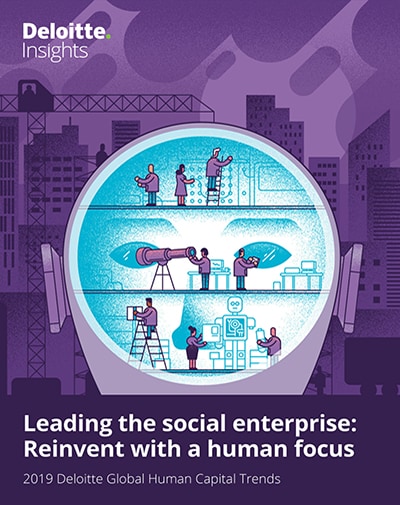
HR cloud: A launch pad, not a destination 2019 Global Human Capital Trends
6 minute read
11 April 2019
Cloud-based systems have not been a panacea for HR—but then, they were never intended to be. Instead, they can give organizations a solid foundation for integrating the explosion of new tools that HR software vendors are now developing.
Over the last few years, significant progress has been made in HR’s move to the cloud. But although cloud computing platforms have, in general, been wildly successful, many vendors have had challenges keeping up with innovative talent management practices, driving organizations to adopt best-of-breed solutions to fill the gaps. In addition, many of the organizations adopting cloud-based human capital management (HCM) systems are not placing enough emphasis on complementary transformational activities such as redesigning their operating model, data architecture, and user experience. This is leading to technology implementations that are not delivering their full potential. Nonetheless, cloud-based HCM is establishing a foundation for change and innovation, enabling organizations to shift their energies toward more pressing challenges.
Learn more
Watch the related video for this trend
View 2019 Global Human Capital Trends
Download the Deloitte Insights and Dow Jones app
Download the full report or create a custom PDF
Deloitte’s 10th annual Global Human Capital Trends Report is coming soon. Get it first by signing up!
HR technology continues to be a major challenge. In this year’s Global Human Capital Trends survey, 74 percent of respondents rated the topic important or very important, and 21 percent called it one of the three most urgent topics their organizations faced moving into 2019. While billions have been invested in integrated cloud-based systems, many organizations tell us they are still not satisfied, and research shows that the average satisfaction with these systems is only 3.3 out of 5, a drop of 3 percent over last year.1 Despite the intense interest in better data management, only 26 percent of respondents report effectively using technology and analytics, and only 6 percent believe their HR technology is excellent. In fact, after investing more than US$20 billion in HR technology over the last five years,2 65 percent of our survey respondents still report that their technology is inadequate or only fair at achieving its overall objectives.
The cloud: Expectations versus reality
One of the biggest HR trends in the last few years has been the adoption of subscription-based cloud systems, which were intended to reduce the need for IT to maintain HR software, provide a more integrated suite of tools, improve data management, improve the user experience, and deliver faster innovation. Organizations have experienced varying degrees of success in each of these areas.
First, many organizations still have a mixed set of HR systems in place. Only 5 percent of this year’s survey respondents told us they have a fully integrated HR cloud platform. Most of the others have some combination of cloud and on-premise software, and 29 percent have no systems at all. Since many organizations are still using and maintaining numerous HR systems, the quality of the user experience and the level of integration have not reached the levels often promised by HCM cloud vendors. Many organizations are using employee engagement layers to improve their solutions’ overall usability and to provide a higher level of technical and functional integration.
Second, most cloud vendors have not been keeping up with rapid business innovation and technological advancements. The average HR department now has more than nine systems of record—up from eight a year ago—demonstrating that organizations continue to buy multiple solutions to meet their needs.3 A huge proliferation of software by innovative new vendors has appeared in the talent management space, creating a new artificial intelligence (AI)-based talent management market with which many major enterprise resource planning (ERP) vendors are struggling to keep pace. Additionally, the market for, and the technology supporting, robotics and cognitive automation has grown quickly, outpacing the ERP vendors’ product road maps and releases.
Third, cloud vendors have, in some cases, oversold their systems’ capabilities. When we asked respondents to tell us what they expected versus what they realized from the cloud, the results were mixed (figure 1).

As the data in figure 1 shows, the cloud helps organizations consolidate data, create a single user interface, and improve access to data. But it also demonstrates that cloud, in and of itself, has not had a major positive impact on the employee experience, HR operations, or innovation.
Digital HR: Still aspirational
Several years ago, we wrote about “digital HR,” referring to the desire to digitize HR processes, deliver easy-to-use mobile apps to employees, and create a more service-oriented HR function.4 Our research this year shows that some progress has been made on this front: Twenty-six percent of survey respondents believe they have been better able to act as service-oriented HR business partners. One company that has advanced in this area is Tencent, an internet-based technology and cultural enterprise headquartered in China, which is launching a cloud-based HR platform featuring user-driven, open collaboration and lightweight, convenient HR solutions and services.5 And a global retailer has recently deployed an integrated online HR experience for employees and HR that incorporates advanced capabilities such as chatbots and automation.6
Yet our survey also shows that there is much work still to do. Overall, only 5 percent of respondents believed that their HR technology was doing an excellent job meeting full-time workers’ needs—and only 2–3 percent believed that it was excellent at meeting the needs of alternative or part-time workers. In the areas of general productivity and information tools, many organizations are also still behind. When we asked respondents to rate their organizations’ abilities to deliver the tools and technologies they need to do their jobs, only 35 percent were satisfied. In short, digital HR still has some major work ahead.
Intelligent tools and experience platforms: Coming on strong
The HR technology market is rapidly evolving to try to meet organizations’ needs. Today, more than 1,400 HR technology vendors are in the market,7 many focused on using AI, cognitive interfaces, advanced analytics, sentiment analysis, and other new technologies designed to make work easier.
The explosion of tools covers almost every imaginable area of HR. Vendors are developing tools for internal talent mobility; tools to help identify and reduce bias and discrimination in hiring and promotion; advanced benchmarking tools to help organizations compare their salaries and hiring practices with those of their peers; AI-based tools to coach employees, assess leaders, and give people well-being and developmental nudges to make work easier; and more. And major payroll vendors are rewriting their software to make it more real-time and flexible for part-time work. Some recent and anticipated coming innovations include:
- Dozens of tools to deliver pulse surveys, give feedback, and measure engagement, often coupled with tools for performance management, to give organizations a better real-time view of the employee experience;
- Well-being tools that provide coaching and access to medical specialists, record real-time data about health and fitness, and promote mindfulness at work;
- Performance management and analytics tools to help organizations deliver real-time data to managers about employee sentiment, performance management, goal attainment, and ongoing development;
- A massive array of tools to support self-directed learning, curation and recommendation of learning programs, career management, internal mobility, and mobile and microlearning;
- New systems to find job candidates, create recruitment portals, help improve recruiting efficiency, and apply chat and AI-based tools to the assessment, screening, and interviewing process;
- Video- and AI-based tools to assess job candidates and evaluate employee sentiment and engagement; and
- Tools designed to identify bias and to enable employees to report grievances and problems, aimed at reducing harassment in the workplace.
Rewiring the connections
While HR has blazed new trails through its early adoption of cloud platform solutions, automating and enhancing HR with advanced digital solutions that reshape how work gets done is imperative. Many have begun to apply robotic process automation and even artificial intelligence technologies to traditional HR activities. The introduction of virtual reality, machine learning, and social collaboration can make it possible to truly reinvent rather than only automate.8 This will enable organizations to rewire their people operations, creating new connections that can yield many benefits: a better workforce experience; a stronger connection among performance, learning and development, and rewards; and greater insights from using analytics across the enterprise.
Luckily, a new category of unified engagement platforms has emerged, focused on giving workers a single interface to find and access information in the heterogeneous HR market. These platforms are offering more than an improved worker experience; they are helping to create new connections that improve other aspects of HR service delivery. One example is the potential to integrate case management, knowledge management, and chatbots into a mobile experience that blends well with existing core human capital management platforms. Technologies like these promise to truly reinvent HR’s relationship with the workforce, enabling HR to not only deliver a positive human experience, but also redirect its own time and attention to other emerging needs of the social enterprise.
The bottom line: While many of the challenges with HR technology remain, the pace of development has quickened, giving organizations a tremendous range of options in their plans for the future. The idea of a single, integrated cloud platform has not solved everything—but it has given organizations a solid foundation on which to build. Organizations are now deploying new architectural teams to identify and integrate new tools, and a new world of talent management software is emerging.

© 2021. See Terms of Use for more information.
Explore the collection
-
From employee experience to human experience Article6 years ago
-
Accessing talent Article6 years ago
-
Talent mobility Article6 years ago
-
Rewards Article6 years ago
-
Looking ahead Article6 years ago
-
2019 Global Human Capital Trends Collection





















